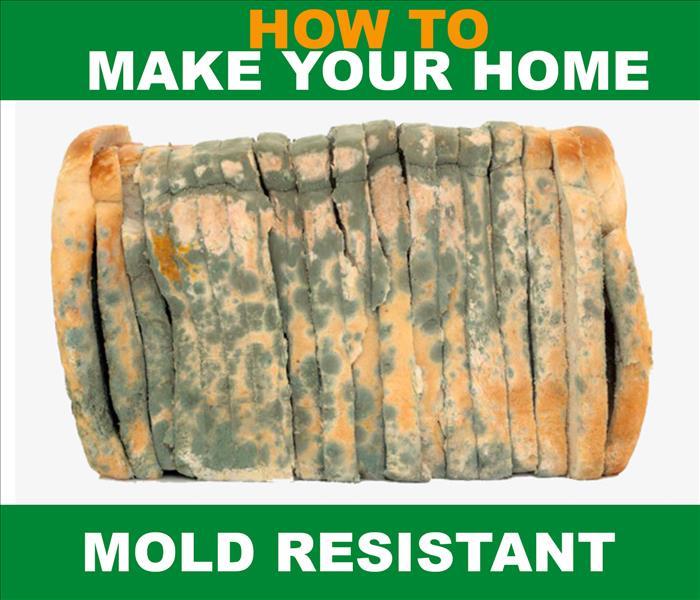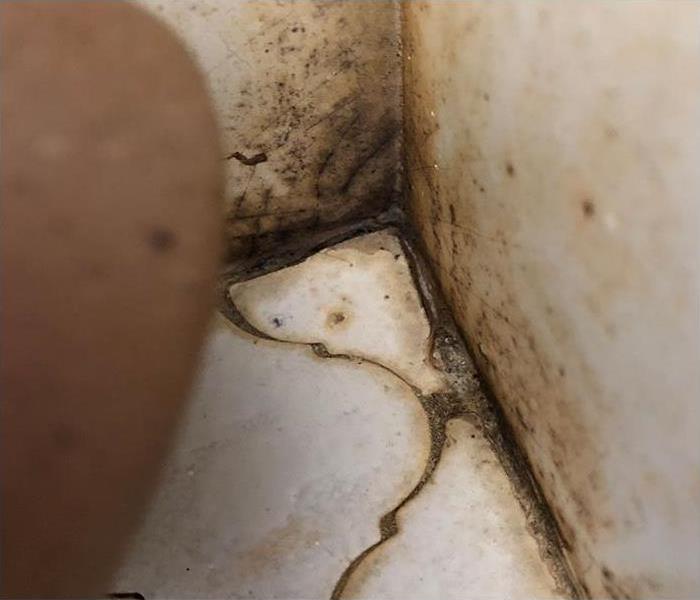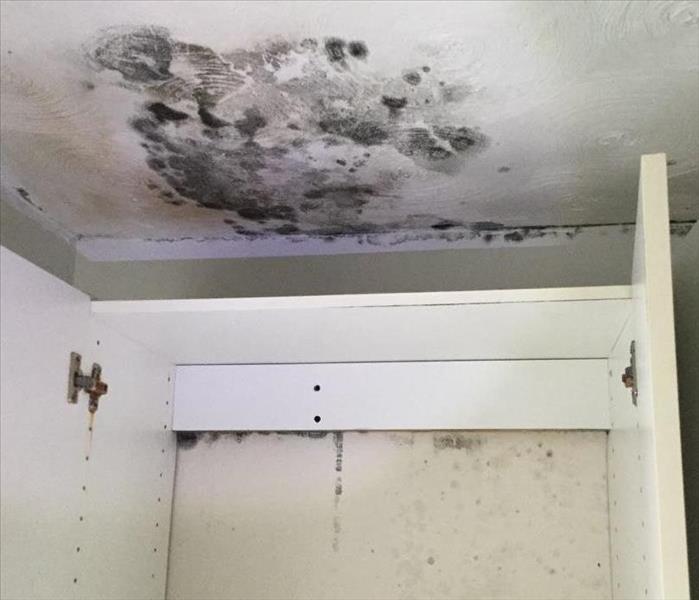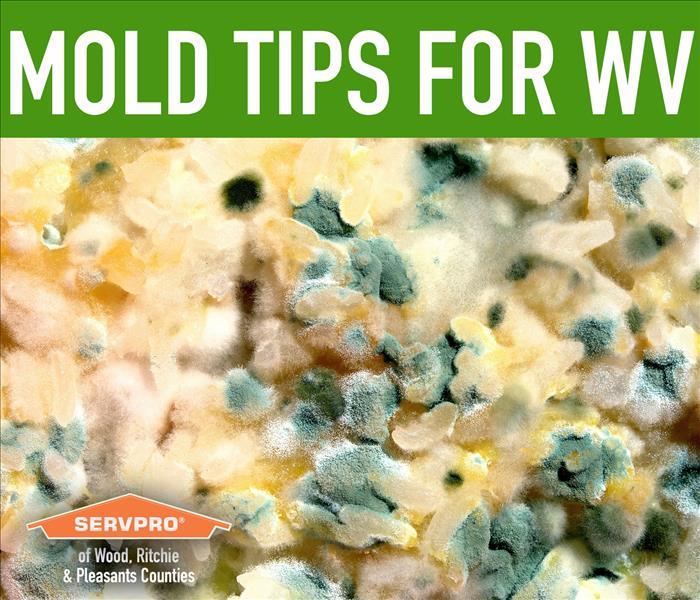Recent Mold Remediation Posts
4 Ways To Remove Mold WITHOUT Professional Help
9/20/2020 (Permalink)
Article at a glance:
- Unattended Mold May Be Dangerous, so do this ...
- Our simple guide to mold removal, and the maintenance of at-risk areas
Mold is a sneaky and common problem in most West Virginian households. Especially in the fall. ‘Out of sight, out of mind’ is a dangerous mentality. Simply wiping away mold will not save your property or wallet. In fact, by doing this you may be creating a bigger problem (we will show you how to avoid this soon).
Lucky for you, mold removal is safe and affordable when you know exactly how to do it. At the end of this article, you’ll feel confident enough to tackle the smelly problem yourself, and keep it away.
The Dangers & Damage of Mold
- Stains & Odors - Have you ever smelled that musty smell when you enter a room? That unpleasant smell that leaves guests feeling uncomfortable but most likely feeling too polite to say anything. What’s more embarrassing is that you might not even smell it anymore! In addition to this smell, the mold may have grown on the surface of cupboards, floors and walls, creating awful stains. These stains are often black or a deep yellow. While you might be able to wipe the mold off, you might be stuck with discoloured walls.
- Clothing Damage - Mold can appear within 24 to 48 hours. While you might only see a stain on your cupboard, mold can also migrate into your clothing. Be careful of this because replacing or repairing your mold-damaged clothing can sometimes cost over hundreds of dollars.
- Health Effects - Your health comes first. Not only does mold target and damage beloved items and the structure of our homes, it can also have serious effects on your health or your family’s health. Follow our easy mold removal tips below to help keep everyone, and everything safe.
Mold can be dangerous, and can be expensive to remove. But can you do it yourself? YES! (Well, to a degree). Mold removal doesn’t have to be expensive to fix if we treat the problem accordingly. So follow our helpful tips on removing mold confidently in your home.
How to Take Care of Mold WITHOUT Professional Help
- Wash your clothes and avoid that large shopping list! As soon as the mold is discovered do a thorough clean of your clothing. To thoroughly kill the mold, try adding vinegar or baking soda to your washer.
- Act Fast. If you hesitate you’ll need to mold remediate. The smallest speck of mold can create big problems. Time is your enemy and the mold’s friend. As soon as you notice a smell or stain, wipe it away and thoroughly clean the area.
- Water won’t help. When it comes to mold, you will need to tackle it with something stronger. Try mixing ¼ water, 2/4 baking soda and ¼ white vinegar. This strong blend will help get rid of the smell and stain.
- Don’t wipe, scrub! If we want this problem gone for good, we can’t just wipe it off the surface. Use a rough cloth or toothbrush to scrub the area clean.
Please note that mold often grows below the surface. It grows within the drywall, under wood and within our furniture. Cleaning this thoroughly can be extremely difficult, but if it’s not taken care of fast, the mold will continue to grow throughout your home.
If you have any further questions please call us on 304 428 7378 or click here to contact us.
The Team at SERVPRO of Wood, Ritchie & Pleasants Counties.
Related Articles:
Black Toxic Mold - What You Can Do To Avoid It
Is Mold Hiding From You?
5 Way Mold Grows in West Virginian Homes (and how to Prevent It)
7/20/2020 (Permalink)
West Virginian summers are mostly humid with an average temperature of 46 °F, and this can be prime for mold to grow.
Mold belongs to the fungus family. It is not the mold you see that is the issue, instead it is the mold spores that are in the air. When inhaled, the spores may cause health effects such as irritations and allergies.
What Causes Mold to Grow In My Home?
Mold colonies need certain environments to grow best. If you can avoid or minimize these you will be able to potentially avoid mold growths in your home. The 5 things that benefit mold growths are:
- Humidity This is the first and foremost factor contributing to the growth of mold. Mold being a living organism that feeds on moisture. A little exposure to a leaking pipe, heat moving through the home or even a clothes dryer in an enclosed space can create moisture in the air and this can quickly give birth to mold colonies in this area of your home.
- Darkness Mold thrives in the dark and quiet places where ultraviolet rays cannot prevent it from growing. Mold flourishes in the dark nooks and corners of the house where sunlight is unable to reach.
- Warmth The outdoor temperature of West Virginia ranges from 25°F-82°F, whereas a mold requires 60°F to grow with full swing. So, it should come as no surprise that the warmth inside of the your home can become a breeding ground for mold due to humidity and moisture created by the differing temperatures from inside to outside.
- Oxygen Like all other living beings, mold feeds on oxygen. The combination of warmth, moisture and oxygen in areas such as your home basement or bathrooms create a feeding ground for mold.
- Food Mold needs food to thrive. The question is, what does mold eat? Well, it can be your drywall, meat, and wood to name a few. Black toxic mold is fond of cellulose, which is commonly found in wood and paper (your walls).
How Do You Prevent Mold From Growing?
Now that we know the common reasons behind mold growth, we can equip ourselves with mold remediation methods to minimize (or even remove) the ability for mold to grow.
Here is how to prevent mold from taking over your house in a few convenient steps;
- To Avoid Humidity: a constant air flow decreases humidity. An exhaust fan is the simplest way to do this. Install an exhaust fan in your bathroom(s), kitchen and basement and use them whenever heat is present (for example, a hot shower or bath, cooking or hot water system is on in the basement).
- Other methods to improve air flow are:
- Keep Basement tidy. A build up of items can minimize or restrict airflow. If water or moisture becomes present in any area of the basement you are likely to be feeding the mold now with stagnant air.
- Clean and dry every moist surface areas across your house.
- Frequently check pipes for blockages. This is a similar rule to the exhaust fans.
- Make use of mold killing products for cleaning the bathrooms, tubs, and sinks.
- Immediately dispose of materials infected with mold.
- In the extreme case of mold accumulation or possibly even black toxic mold, please seek professional advice because the high amount of mold may cause health problems. Your safety and heath is priority.
If you want any more questions answered or even would like us to have a look at your mold issues and see if we can help further, please call us right now on 304-428-7378 or contact us through our form by clicking here.
We hope this has helped.
From the team at SERVPRO of Wood, Ritchie & Pleasants Counties.
RELATED BLOG POSTS:
Black Toxic Mold
How to Make Your Home Mold-Resistant in 8 Easy to Follow Steps
12/2/2019 (Permalink)
 Mold is born in moisture and a lack of airflow
Mold is born in moisture and a lack of airflow
Mold is a common household guest. Mold may cause health effects without us even knowing. For this reason, the article you are reading is designed to better equip you with moisture prevention and ultimately mold prevention in your home. After reading this article you will know better how to prevent mold in your home and commercial building in Parkersburg, WV and surrounding areas.
First, we must know why mold is potentially harmful to us.
Why Remove the Mold?
Most mold that builds up in our homes and offices give out spors. These spors travel through the air and we breathe them in.
Some mold can also contain many irritants and allergens, which may cause health effects. Very few types of mold contain toxins, however its is important to know the difference. One type is Toxic Black Mold. At the end of this article we will contain a link on “How to Determine if You have Black Toxic Mold In Your Home”.
Where does Mold typically grow in our home?
Mold grows in areas that are moist and do not have much air flow. Common areas that mold grow include: the showers and bathroom, clothing and inside water bottles. Other, less visible or even hidden areas include: under the carpets, backside of the drywall and inside walls, pipes and ceiling tiles.
Even if the mold is hidden, it can negatively effect our health because it is the air in which the spors are transported.
What are the steps to stop it growing?
The main goal with mold control comes down to one simple rule: moisture control. In the next 8 points you will know exactly how to moisture control your home and ultimately minimise the possibility of mold growing in your home.
- Identify problem areas in your home and correct them. While it is not possible to make your home completely “mold proof” you can make it “mold resistant”. Look around your home first and identify the problem areas. Some suggestions of what to look for include: Does the basement flood? Do any windows get frequent condensation? Are there any water stains on the walls or roofs? Once you’ve done this, go immediately to step 2.
- Dry wet/damp areas immediately. No moisture - no mold growing. Therefore the more proactive you are with removing the moisture / water, the harder it is for mold to grow and thrive. Side Note: Do not leave wet clothes in the washing machine. Mold can spread very quickly and this is very common in homes where we easily forget about our clothes.
- Proper ventilation. It is often our bad habits that help mold to grow in our homes. When cooking, showering or anything that includes steam always be sure to properly ventilate the room and home. This can be as simple as opening a window (yes even in winter) or having an exhaust fan in the room or a dehumidifier.
- Use Mold-resistant products. This is a harder one because it can be a costly one compared to the above. BUT once done, less work and time is needed on your behalf. Common dry wall allows little ‘pockets’ for mold to sit in comfortably. This is because it’s made of gypsum plaster core pressed between plies of paper. Whereas with mold resistant drywall the gypsum core is covered in fibreglass instead. This makes it highly water-resistant.
- Monitor the humidity indoors. According to the EPA, indoor humidity should be between 30% and 60%. Humidity meters are available at any local hardware store. Once you have the meter, you’ll be able to detect the high humidity areas in your home and follow step two again.
- Direct water away from the home. Make sure that the ground around your home is sloped slightly away from your home. Otherwise your home quickly builds up water. Not only does this make it vulnerable to mold build up, but also flooding and flooding damage, which can be very costly to fix.
- Clean or repair roof gutters. Often cases with mold derive from a leaking roof or damaged gutters. Check: that your gutters are cleaned regularly and inspected properly for damage. If damaged: repair as soon as possible.
We hope that these pointers have helped you understand further. Mold is something every home should avoid as it is an unnecessary, potential health risk in your home. And your health must be primary.
To read further about Black Toxic Mold and how to determine if it is present in your home, please click here to read.
If there are any other questions or concerns you may have please do not hesitate to call our friendly and knowledgeable staff on 304-428-7378.
Keep safe!
The team at SERVPRO of Wood, Ritchie & Pleasants Counties
Black Toxic Mold - What You Can Do To Avoid Having This Health Risk In Your Family Home
10/7/2019 (Permalink)
Mold is easily found in everyone's home or workplace. We've all seen it. We've all overlooked it. However some molds can potentially cause health effects if exposed to it too long. But no need to start freaking out, knowledge is power, and in this blog post you will learn how to differentiate between black mold and black toxic mold.
What is Black Mold?
Black mold has a black pigment, however this does not necessarily mean that it is toxic. There are multiple kinds of black mold that include nigrospora, cladosporium and alternaria, but lets face it, you're not here for a mold education, you just want to know if it's toxic or not.
What Makes Mold Toxic?
The toxic component, (mycotoxins) in mold are found in the spores that travel through the air. When inhaled these may effect our health.
How Can I Determine Black Toxic Mold?
The black toxic mold, named Stachybotrys chartarum, is dark black or sometimes even dark green. For this mold to grow, the surface that it is on needs to be wet for at least 72 hours (3 days) and have access to moisture the that entire time.
The Environment Will Determine The Mold Growth
The growth of Black Toxic Mold lies within the environment around it. This includes the following:
- Poor or limited ventilation/air flow
- Moisture in the air
- Moisture on the surface
Here are some images of black toxic mold. Have a scroll through and then come back to this page to find out what to do next.
Click here for black toxic mold images
What Should I Do With Mold In My Home?
If your health and your families health is a priority, we always recommend mold remediation from an expert. An expert can determine the severity of the mold outbreak and what are the necessary steps for complete removal.
For a free quote, call SERVPRO of Wood, Ritchie & Pleasants Counties now on 304-428-7378.
We hope that this has been helpful, your health and safety is our priority.
Please share this with friends and family on your social media so that they can be informed too.
Does Ventilation Stop Mold or Help it Grow?
9/23/2019 (Permalink)
One of the common questions we get about mold is "how can I stop mold growing in my home?" It's important to think about because prevention is always better than cure.
If you never get mold, you'll never need us.
So we wanted to help share some insight into mold prevention so that your home can stay mold-free.
All ventilation is not created equal
Mold thrives in humid environments. This is because the moisture in the air feeds it, creating an environment for the mold to grow and prosper.
Common places for mold to appear are bathrooms (the hot showers), kitchen (steam from cooking), attics and basements. All these environments have one common thing - steam.
How Should I Ventilate My House?
The main goal of your ventilation is to allow the steam and moisture to escape. Luckily ventilation is more simpler than it sounds. This can be as easy as two options:
- Open the window Yep. Let that steam get out. It might be a little colder inside for the moment, so we recommend throwing on a warm top and pants while the steam escapes.
- Install an exhaust fan If you would prefer to keep the window closed, installing an exhaust fan would be a great option. But it's very important to remember to turn it on every time there's steam present (when you're in the hot shower, when cooking).
Invest in Your Health
When installing an exhaust fan it's important to not cut costs unnecessarily. These two simple steps include:
- Buying a better quality fan this might be a little more expensive but will mean a more effective job. Plus, the fan is likely to last longer (which will ultimately save you money long term).
- Have a professional install it Unless you are very experienced in the topic, we would recommend having it professionally installed. Again, this will ensure it working properly as well as it lasting longer.
We hope that this has helped. Please share this blog post on your social media so that others can find out how to keep their homes mold-free.
From the team at SERVPRO of Wood, Ritchie & Pleasants Counties.
Is Mold Hiding From You?
8/19/2019 (Permalink)
 Mold hiding in a bathroom.
Mold hiding in a bathroom.
We’re sure you’ve smelt it before. That musty smell in a room, maybe your basement, or your bathroom, maybe even your bedroom. That may be a sign of mold growing within your home.
This mold is just as dangerous as the visible mold.
Mold can be growing in numerous places out of your sight:
- Behind the dry wall
- Under the carpet
- Underneath the wallpaper
- In the wall panelling
- Within furniture
Mold grows anywhere where there’s moisture. But before you pack your bags to move home, or start tearing down the dry wall to find it, here’s some small steps you can take.
- Call a professional for an inspection.
- We will ask a few questions over the phone, so have these prepared so that your process is easier
- Can you see the growth? (In this instance, you cannot)
- Does the room have much moisture in it naturally?
- Have you remove the moisture?
These questions will help us understand the situation better and give you the best information possible. If there is anything you’re uncertain about regarding mold in your home, do not hesitate to call us on 304-428-7378.
Thankyou from the team at SERVPRO of Wood, Ritchie & Pleasants Counties.
Does Your Wood, Ritchie, or Pleasants County Home Have A Mold Problem?
10/25/2018 (Permalink)
 Be careful! Without proper training, you could be spreading mold throughout your home.
Be careful! Without proper training, you could be spreading mold throughout your home.
Microscopic mold spores naturally occur almost everywhere, both outdoors and indoors. This makes it impossible to remove all mold from a home or business. Therefore, mold remediation reduces the mold spore count back to its natural or baseline level. Some restoration businesses advertise “mold removal” and even guarantee to remove all mold, which is a fallacy. Consider the following mold facts:
- Mold is present almost everywhere, indoors and outdoors.
- Mold spores are microscopic and float along in the air and may enter your home through windows, doors, or AC/heating systems or even hitch a ride indoors on your clothing or a pet.
- Mold spores thrive on moisture. Mold spores can quickly grow into colonies when exposed to water. These colonies may produce allergens and irritants.
- Before mold remediation can begin, any sources of water or moisture must be addressed. Otherwise, the mold may return.
- Mold often produces a strong, musty odor and can lead you to possible mold problem areas.
- Even higher-than-normal indoor humidity can support mold growth. Keep indoor humidity below 45 percent.
If your home or business has a mold problem, we can inspect and assess your property and use our specialized training, equipment, and expertise to remediate your mold infestation.
If You See Signs of Mold, Call Us Today 304-428-7378





 24/7 Emergency Service
24/7 Emergency Service




